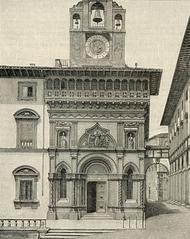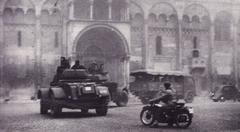
Santa Maria della Pieve Arezzo: Visiting Hours, Tickets, and Essential Guide to Historical Sites
Date: 04/07/2025
Introduction
Santa Maria della Pieve, set in the heart of Arezzo, Tuscany, is a Romanesque masterpiece that stands as a symbol of the city’s layered history, art, and architectural innovation. Known for its striking façade, the iconic bell tower (“Torre dei Cento Buchi”), and treasures like Pietro Lorenzetti’s polyptych, the church is both a spiritual landmark and a must-visit for anyone exploring Tuscany. Whether you are drawn by medieval architecture, sacred art, or Arezzo’s vibrant culture, Santa Maria della Pieve offers an immersive journey through centuries of creativity and devotion.
This comprehensive guide covers everything you need for your visit: historical context, architectural highlights, visitor information (opening hours, tickets, accessibility), travel tips, nearby attractions, and essential FAQs. With free admission, central location near Piazza Grande, and the option of guided tours, Santa Maria della Pieve is an accessible highlight for all travelers. Enhance your experience with resources such as the Audiala app, and discover why this church remains an enduring centerpiece of Arezzo’s cultural tapestry.
(Antiche Mura, Savoring Italy, Discover Arezzo)
Table of Contents
- Introduction
- History and Cultural Significance
- Architectural and Artistic Highlights
- Visitor Information
- Nearby Attractions
- Events and Special Occasions
- Frequently Asked Questions (FAQ)
- Plan Your Visit
- Conclusion
- References
History and Cultural Significance
Santa Maria della Pieve is among Arezzo’s oldest churches, with roots possibly stretching back to early Christian worship in the 5th or 6th centuries. By the 9th century, it was already established as a “Pieve”—a parish church with baptismal rights, signifying its spiritual and civic importance to the medieval city.
The Romanesque structure seen today emerged from a 12th–13th century reconstruction, supported by the city’s growing influence. Notable features such as the three-tiered loggia façade and the raised presbytery above a crypt echo this period’s architectural innovation. In 1330, the distinctive bell tower was completed, offering a vertical counterpoint to the church’s horizontal massing.
Artistic and liturgical significance grew in the 14th century, particularly with the addition of Pietro Lorenzetti’s polyptych and the reliquary bust of St. Donatus. Later restorations—such as those by Giorgio Vasari in the Renaissance—were carefully balanced by 19th-century efforts to preserve the original Romanesque character.
Today, Santa Maria della Pieve remains a living hub of Arezzo’s religious life, community identity, and cultural celebrations, including major events like the Giostra del Saracino.
(Antiche Mura, Discover Arezzo)
Architectural and Artistic Highlights
Exterior and Façade
The church’s façade is a distinctive example of Tuscan Romanesque style: three superimposed loggias, each with a unique arrangement of columns and capitals, create a rhythmic verticality rare in medieval architecture. None of the capitals are identical, showcasing the creativity of local craftsmen. Iconic sculpted reliefs—including the “Cycle of the Months,” a sequence of agricultural motifs from c. 1210—decorate the main portal, offering a glimpse into medieval life. Above the portals, lunettes depict sacred scenes such as the Madonna with Angels and the Baptism of Christ.
(antichemura.it, nomads-travel-guide.com)
The Bell Tower (Torre dei Cento Buchi)
Completed in 1330, the Torre dei Cento Buchi (“Tower of a Hundred Holes”) rises nearly 60 meters, with forty double-arched Romanesque windows that give the appearance of numerous “holes.” Its cylindrical silhouette and rhythmic fenestration make it one of Arezzo’s most recognizable landmarks and a favorite subject for photographers.
(renatoprosciutto.com, summerinitaly.com)
Interior and Artistic Treasures
Inside, three naves are separated by columns with intricately carved capitals. The raised presbytery sits above a crypt, reflecting the transition from Romanesque to early Gothic. Key artistic highlights include:
- Pietro Lorenzetti’s Polyptych (1320): A celebrated Sienese Gothic altarpiece depicting the Madonna and Child with saints, marking an evolution toward naturalism in Italian painting.
- Reliquary Bust of St. Donatus (1346): A silver and gilded copper masterpiece of medieval goldsmithing, central to Arezzo’s religious traditions.
- Frescoes and Bas-Reliefs: 13th-century marble reliefs, a 14th-century fresco by Andrea di Nerio, and historic wooden crucifixes enrich the church’s sacred atmosphere.
- The Crypt: Accessible via stairs, it houses ancient columns and the relics of St. Donatus, offering a tangible link to the church’s early origins.
(antichemura.it, nomads-travel-guide.com)
Apse and Rear Elevation
Viewed from Piazza Grande, the apse’s blind arches and unique columns—including one “broken” column—demonstrate both structural ingenuity and artistic flair. The slightly pointed pre-Gothic arches hint at the stylistic transition underway during the church’s construction.
(travelingintuscany.com)
Visitor Information
Opening Hours & Admission
- Hours: Open daily from 9:00 AM to 6:00 PM (may close midday or for services; hours can vary on holidays—check the official website or tourist office for updates).
- Admission: Free entry to the main nave; donations appreciated. Special exhibitions or crypt access may require a small ticket.
- Accessibility: Main areas are accessible, though the crypt is reached by steps. Contact the church in advance for assistance if mobility is a concern.
(Savoring Italy, Love from Tuscany)
Guided Tours & Information
Guided tours—offered by local operators or booked through the Arezzo visitor center—provide valuable historical and artistic context. Audio guides and informational panels are available on site, though English-language materials may be limited. Consider using a mobile app (like Audiala) for enhanced interpretation.
(Savoring Italy)
Travel Tips
- Wear comfortable shoes for cobblestone streets.
- Dress modestly (shoulders and knees covered).
- Photography is permitted without flash or tripods.
- Early morning or late afternoon visits offer a quieter atmosphere and beautiful lighting.
- The church is less crowded than many Tuscan attractions, making for a relaxed visit. (Dream Plan Experience)
Nearby Attractions
Santa Maria della Pieve’s central location makes it easy to combine with:
- Piazza Grande: The city’s main square, host to the antiques market and cultural events.
- Arezzo Cathedral (Duomo): Renowned for Gothic architecture and Piero della Francesca’s frescoes.
- Casa Vasari: Home and art collection of Giorgio Vasari.
- Basilica of San Francesco: Famous for Piero della Francesca’s “Legend of the True Cross” frescoes.
- Medici Fortress: Offers panoramic city views. Plentiful cafés and artisan boutiques nearby make for a pleasant break before or after your visit. (Love from Tuscany, Savoring Italy)
Events and Special Occasions
Santa Maria della Pieve is a focal point during Arezzo’s major festivals, such as the Giostra del Saracino—a historic jousting event filling the surrounding streets with medieval pageantry (Love from Tuscany). The church also hosts concerts, liturgical celebrations, and community events throughout the year.
Frequently Asked Questions (FAQ)
What are the opening hours of Santa Maria della Pieve?
9:00 AM to 6:00 PM daily; check for possible midday closures or special events.
Is there an admission fee or ticket required?
Entry to the main nave is free. Donations are appreciated; special areas may require a small ticket.
Are guided tours available?
Yes, through local operators or the tourist office. Audio guides are also available.
Is the church accessible for visitors with disabilities?
Most areas are accessible, but the crypt can only be reached by stairs. Contact ahead for accommodations.
Can I take photographs inside?
Yes, but no flash or tripods.
What is the best time to visit?
Early mornings or late afternoons on weekdays for a quieter experience.
Plan Your Visit
Santa Maria della Pieve is easily reached on foot from the train station (10–15 minutes) or from anywhere in Arezzo’s historic center. Its location on Corso Italia places it at the heart of city life and close to other major attractions. For the latest information, download the Audiala app or consult the Arezzo tourism website.
Visuals and Suggested Media
- Image of Santa Maria della Pieve façade with alt text: “Romanesque loggias of Santa Maria della Pieve in Arezzo”
- Photo of the bell tower titled “Tower of a Hundred Holes, Arezzo”
- Close-up of Pietro Lorenzetti’s polyptych with alt text: “Pietro Lorenzetti’s 1320 polyptych inside Santa Maria della Pieve”
- Map highlighting Santa Maria della Pieve and nearby attractions in Arezzo
Conclusion
Santa Maria della Pieve is a remarkable embodiment of Arezzo’s medieval artistic and architectural heritage. Its unique Romanesque façade, iconic bell tower, and artistic masterpieces offer a compelling experience for all visitors. The church’s free admission, central location, and ongoing role in local culture make it a highlight of any Tuscan itinerary. Whether you are passionate about art, fascinated by history, or simply seeking the authentic atmosphere of Arezzo, Santa Maria della Pieve promises a memorable visit.
(Antiche Mura, Love from Tuscany, Savoring Italy)
References
- Antiche Mura – Santa Maria della Pieve
- Discover Arezzo – The Churches of Arezzo
- Savoring Italy – Is Arezzo Worth Visiting?
- Love from Tuscany – Arezzo
- Dream Plan Experience – Is Arezzo Worth Visiting?
- Renato Prosciutto – Santa Maria della Pieve
- Nomads Travel Guide – Santa Maria della Pieve
- Traveling in Tuscany – Santa Maria della Pieve
- Summer in Italy – Santa Maria della Pieve






